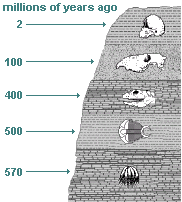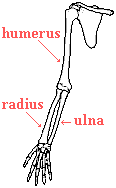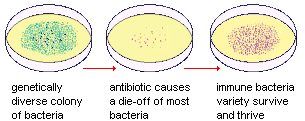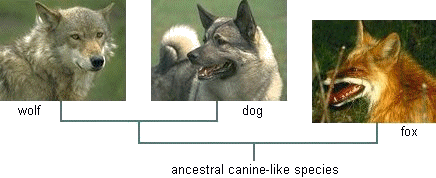Evidence of Evolution
The Nobel Prize winning scientist Linus Pauling aptly described
science as the search for truth. Science does this by continuously
comparing its theories objectively with evidence in the natural world.
When theories no longer conform to the evidence, they are modified or rejected
in favor of new theories that do conform. In other words, science
constantly tries to prove its assumptions to be false and rejects implausible
explanations. In this way, scientific knowledge and understanding grow
over time. Religious explanations for the order of things are not
science because they are based primarily on faith and do not subject
themselves to be objectively falsified. Because of this fundamental
difference in the approach to understanding the natural world, the U.S.
Supreme Court decided in 1987 that the Biblically based "Creation Science" is
not a science and cannot be taught as such in public schools as an alternative
or in addition to the mainstream evolutionary theory of the biological
sciences. However, religious creation stories can be taught in
philosophy, religion, or history courses. Religion and Science provide
different approaches to knowledge. It is important to understand
both.
What is
Evolution?
Biological
evolution is genetic change in a population from one generation to
another. The speed and direction of change is variable with different
species lines and at different times. However, continuous evolution over
many generations can result in the development of new varieties and
species. Likewise, failure to evolve in response to environmental
changes can, and often does, lead to extinction.
When scientists
speak of evolution as a theory they do not mean that it is a mere
speculation. It is a theory in the same sense as the propositions that
the Earth is round rather than flat or that our bodies are made of atoms are
theories. Most people would consider such fundamental theories to be
sufficiently tested by empirical evidence to conclude that they are indeed
facts. As a result of the massive amount of evidence for evolution
accumulated over the last two centuries, we can safely conclude that evolution
has occurred and continues to occur. All life forms, including people,
evolved from earlier species. Furthermore, all still living populations
of organisms continue to evolve today. We now understand that there are
a number of different natural processes that can cause evolution to
occur. These are presented in later tutorials of this
series.
For those who have
difficulty in accepting evolution because of what they perceive as
contradictions with their fundamental religious beliefs, it may be useful to
distinguish the ultimate origin of life from its later evolution. Many,
if not most, biological scientist accept that primordial life on Earth began
as a result of chance natural occurrences 3.5-4 billion years ago.
However, it is not necessary to believe in that view in order to accept that
living creatures evolved by natural means after the origin of the first
life. As far as we know, Charles Darwin modified his religious beliefs,
as did many others, as a result of the discovery of convincing proof of
evolution. Apparently, he came to believe that his God created the order
of the universe including the rules of nature that result in biological
evolution.
How Do We Know
That Evolution
Has Occurred?
The evidence for
evolution has primarily come from four sources:
| 1.
|
the fossil record of change in
earlier species |
| 2. |
the chemical and structural
similarities of related life forms |
| 3. |
the recorded genetic changes in
living organisms over many generations |
| 4.
|
the geographic distribution of
related species |
The Fossil Record
 |
Geological strata
containing an
evolutionary sequence of
fossils |
Remains of animals
and plants found in sedimentary
rock deposits give us an indisputable record of past changes through
time. This evidence attests to the fact that there has been a tremendous
variety of living things. Some now extinct species had traits that were
transitional between major groups of organisms. Their existence confirms
that species are not fixed but can evolve into other species over
time.
The evidence
also shows that what have appeared to be gaps in the fossil record are due to
incomplete data collection. The more that we learn about the evolution
of specific species lines, the more that these so-called gaps or "missing
links in the chain of evolution" are filled with transitional fossil
specimens.
Chemical and Structural
Similarities
Living things on
Earth are fundamentally similar in the way that their basic structures develop
and in their chemical compositions. No matter whether they are simple
single celled protozoa or
highly complex organisms with billions of cells, they all begin as single
cells that reproduce themselves by similar division processes. After a
limited life span, they also all grow old and die.
All living
things on Earth share the ability to create complex molecules out of carbon
and a few other elements. In fact, 99% of the proteins, carbohydrates,
fats, and other molecules of living things are made from only 6 of the 92 most
common elements. This is not a mere coincidence.
All plants and
animals receive their specific characteristics from their parents by
inheriting particular combinations of genes. Molecular biologists have
discovered that genes are, in fact, segments of DNA
molecules in our cells.
 |
section of a DNA
molecule |
These segments of
DNA are chemically coded recipes for creating proteins by linking together
particular amino acids in
specific sequences.
 |
simple protein
molecule |
All of the tens of thousands of types of
proteins in living things are made of only 20 kinds of amino acids.
Despite the great diversity of life on our planet, the simple language of the
DNA code is the same for all living things. This is evidence of the
fundamental molecular unity of life.
In addition to
molecular similarities, most living things are alike in that they either get
the energy needed for growth, repair, and reproduction directly from sunlight,
by photosynthesis,
or they get it indirectly by consuming green plants and other organisms that
eat plants.
 |
|
Human arm bones
(typical
vertebrate pattern) |
Many groups of species share the same types of
body structures because they inherited them from a common ancestor that had
them. This is the case with the vertebrates
, which
are the animals
that have internal skeletons. The arms of humans, the
forelegs of dogs and cats, the wings of birds, and the flippers of whales and
seals all have the same types of bones (humerus, radius, and ulna)
because they have retained these traits of their shared common ancient
vertebrate ancestor.
All of these
major chemical and structural similarities between living things can be most
logically accounted for by assuming that they either share a common ancestry
or that they came into existence as a result of similar natural
processes. These facts make it difficult to accept a theory of special
and independent creation of different species.
Geographic Distribution of Related
Species
Another clue to
patterns of past evolution is found in the natural geographic distribution of
related species. It is clear that major isolated land areas and island
groups often evolved their own distinct plant and animal communities.
For instance, before humans arrived 60-40,000 years ago, Australia had more
than 100 species of kangaroos, koalas, and other marsupials but none of the
more advanced terrestrial placental mammals
such as dogs, cats, bears, and horses. Land mammals were entirely absent
from the even more isolated islands that make up Hawaii and New Zealand.
Each of these places had a great number of plant, insect, and bird species
that were found nowhere else in the world. The most likely explanation
for the existence of Australia's, New Zealand's, and Hawaii's mostly unique
biotic environments is that the life forms in these areas have been evolving
in isolation from the rest of the world for millions of
years.
Genetic Changes Over Generations
The Earth's
environments are constantly changing, usually in subtle and complex
ways. When the changes are so great as to go beyond what most members of
a population of organisms can tolerate, death occurs. As Charles Darwin
observed, however, not all individuals always perish. Fortunately,
natural populations have genetic diversity. Those individuals whose
characteristics allow them to survive an environmental crisis likely will be
the only ones able to reproduce. Subsequently, their traits will be
more common in the next generation--evolution of the population will have
occurred.
This process of
natural selection resulting in evolution can be easily demonstrated over a 24
hour period in a Petri dish of bacteria living in a nutrient medium.
When a lethal dose of antibiotic is added, there will be a mass die-off.
However, a few of the bacteria usually are immune and survive. The next
generation is mostly immune because they have inherited immunity from the
survivors. That is the case with the purple bacteria in the Petri dishes
shown below--the bacteria population has evolved.
Evolution of antibiotic
resistant bacteria
|
 |
This same
phenomenon of bacteria evolution speeded up by human actions occurs in our own
bodies at times when an antibiotic drug is unable to completely eliminate a
bacterial infection. That is the reason that medical doctors are
sometimes hesitant to recommend an antibiotic for their patients and insist
that the full dosage be used even if the symptoms of illness go away.
They do not want to allow any potentially antibiotic resistant bacteria to
survive.
 |
Dog variety
resulting from
selective breeding over
many
generations |
People have
developed many new varieties of plants and animals by selective
breeding. This process is similar to the bacteria experiment described
above. Selection of specimens to breed based on particular traits is, in
effect, changing the environment for the population. Those individuals
lacking the desirable characteristics are not allowed to breed.
Therefore, the following generations more commonly have the desired
traits.
 |
|
Insect with a
high
reproductive potential |
Species that
mature and reproduce large numbers in a short amount of time have a potential
for very fast evolutionary changes. Insects and microorganisms often
evolve at such rapid rates that our actions to combat them quickly lose their
effectiveness. We must constantly develop new pesticides, antibiotics,
and other measures in an ever escalating biological arms race with these
creatures. Unfortunately, there are a few kinds of insects and
microbes that are now significantly or completely resistant to our counter
measures, and some of these species are responsible for devastating crop
losses and deadly diseases.
If evolution has
occurred, there should be many anatomical similarities among varieties and
species that have diverged from a common ancestor. Those species with
the most recent common ancestor should share the most traits. The fact
that wolves, dogs, and other members of the genus Canis are
anatomically very similar, for instance, is due to the fact that they are
descended from the same ancient canine species. Wolves and dogs also
share similarities with foxes, indicating a slightly more distant ancestor
with them.

Given
the abundant evidence supporting the theory of biological evolution, it is
highly probable that evolution has occurred and is still occurring
today. However, there remains speculation in regards to the specific
evolutionary path of some species lines and the relative importance of the
different natural processes responsible for their evolution. It is
likely that these remaining questions will be answered satisfactorily in the
future by further research.
Much
has been added to our understanding of the nature of evolution since the 19th
century. It is now known that there are six different processes that can
operate independently or in consort to bring about evolution. The
understanding of these processes has become the basis for an overall synthetic
theory of evolution . This theory
encompasses multiple causes, including Charles Darwin's concept of natural
selection, Gregor Mendel's experimental results concerning genetic
inheritance, as well as a number of crucial 20th century discoveries.
The synthetic theory of evolution will be revisited with more detail in the
6th tutorial of
this physical anthropology series.
NOTE: Some
critics have said that the kinds of rapid evolutionary changes in insects and
bacteria referred to above are not good evidence of the process of natural
evolution because they occur as a result of human interference. However,
there is abundant evidence of rapid evolution occurring today independent of
people. An example was described by Cristina Sandoval in the May 23,
2002 issue of Nature. A species of insect called the "walking
stick" (Timena cristinae) found in the Santa Ynez Mountains of
California now exists in two distinct varieties or forms that are in the
process of evolving into two separate species by adapting to different
environments. The insect forms differ in terms of genetically determined
color patterns--one is striped and the other is not. The striped ones
hide from predators on the striped chamise plant, while the unstriped ones
hides on the unstriped blue lilac plant. Those that have inherited the
appropriate camouflaging color pattern for their chosen environment survive
the onslaught of lizards and birds. In this case, the natural predators,
rather than humans, are the driving forces of natural selection. Mating
experiments show that each variety of "walking stick" prefers to mate only
with others having the same color pattern. This breeding isolation is
leading to the evolution of two distinct species.







